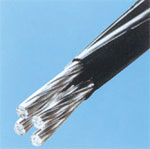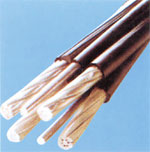Self-supporting insulated conductors (SIP). Advantages and disadvantages
One of the modern requirements for the construction of new and reconstruction of old overhead power lines. is the use of self-supporting insulated wires. SIP is insulated wires twisted into a bundle, one for each of the three phases and one neutral wire. The interweaving of the veins is in the right direction. If necessary, one or two insulated aluminum conductors are added to the public lighting bundle (section 16 or 25 mm).
Self-supporting insulated wires in power supply systems in Russia have been used for more than 10 years, and the length of 0.4×10 kV distribution networks using self-supporting insulated wires is thousands of kilometers. Operational experience accumulated over the years shows the indisputable advantages of insulated conductors over non-insulated ones (grades A and AC).
Consider the pros and cons of using self-supporting insulated wires.How do SIP insulated conductors twisted into a bundle with light-stabilized polyethylene insulation — outperform traditionally used Class A and AC bare conductors?
1. High reliability in the supply of electrical energy.
 2. A sharp reduction (up to 80%) of operating costs caused by high reliability and uninterrupted power supply to consumers, as well as the absence of the need for wide meadows for laying VLI in forests and clearing meadows during the operation of the line.
2. A sharp reduction (up to 80%) of operating costs caused by high reliability and uninterrupted power supply to consumers, as well as the absence of the need for wide meadows for laying VLI in forests and clearing meadows during the operation of the line.
3. Absence or slight contamination of ice and wet snow on the insulated surface of the wires. This is due to the fact that PE is a non-polar dielectric and forms neither electrical nor chemical bonds with the substance in contact with it, unlike, for example, PVC. Cable workers are well aware of this feature of PE. For example, when trying to mark an insulated PE product with a drip method, the paint is easily erased, unlike PVC, and a special email is required. static PE surface treatment for paint retention. For this reason, wet snow easily runs off the round surface of insulated PE wires. In the A and AC wires, wet snow can be trapped in the channels between the wires, which is the main cause of contamination.
4. Reducing the cost of installing VLI associated with cutting a narrower meadow in a forest area, the possibility of installing wires on the facades of buildings in urban development, the use of shorter supports, the absence of insulators and expensive sleepers (for VLI-0.4 kV ).
5.Reduction of power losses in the line due to a reduction of more than three times the reactance of insulated conductors compared to uninsulated.
6. Simplicity of installation work, the possibility of connecting new subscribers under voltage without turning off the rest of the power supply, and as a result, the time for repair and installation is reduced.
7. Significant reduction in unauthorized line connections and incidents of vandalism and theft.
8. Improving the overall aesthetics in an urban environment and significantly reducing the incidence of electric shock during the installation, repair and operation of the line.
 9. Possibility of laying self-supporting insulated wires on the facades of buildings, as well as joint suspension with low and high voltage wires, communication lines, which gives a significant economy of supports.
9. Possibility of laying self-supporting insulated wires on the facades of buildings, as well as joint suspension with low and high voltage wires, communication lines, which gives a significant economy of supports.
Among the many unconditional advantages of SIP, some disadvantages can be distinguished for objectivity:
A slight increase in the cost (no more than 1.2) of insulated wires compared to traditional bare A and AC wires.
There is still insufficient readiness of local power systems to switch to isolated overhead lines due to the lack of information, regulatory documentation, tools and trained personnel.
